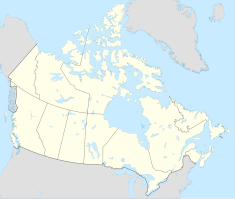St. Victor Petroglyphs Provincial Historic Park[1] is a historical provincial park in the Canadian province of Saskatchewan. The park is located in the RM of Willow Bunch No. 42, about 2 kilometres (1.2 mi) south of St. Victor. The 3.9 ha (9.6 acres) park is situated on the northern slope of the Wood Mountain Upland[2] on a cliff at the top of a partially wooded coulee. The Wood Mountain Hills are a plateau east of the Cypress Hills along the Missouri Coteau in the semi-arid Palliser's Triangle.[3][4] The site was designated as an historic site in the 1960s and became a provincial park in 1986.[5]
| St. Victor Petroglyphs Provincial Historic Park | |
|---|---|
 View of the petroglyphs and countryside | |
| Location | RM of Willow Bunch No. 42, |
| Coordinates | 49°24′42″N 105°52′16″W / 49.4118°N 105.8712°W |
| Original use | Aboriginal sacred site |
| Current use | Historic site |
| Governing body | Saskatchewan Parks |
| Owner | |
| Official name | St. Victor Petroglyphs Provincial Historic Park |
| Designated | 1986 |
St. Victor Petroglyphs Provincial Historic Park features over 360 petroglyphs that have been estimated to have been carved between AD 200 and 1750. They are on a large sandstone outcrop and are the only known example of horizontal petroglyphs on the Canadian Prairies. They also represent the largest concentration of pre-contact rock art in Saskatchewan.[6]
History edit
There is evidence that the petroglyphs were not carved all at one time but rather over a period of hundreds of years by different people as there are a few examples of carvings superimposed on carvings. It is not known exactly who carved them but this rock art is typically attributed to the people of the Siouan languages. There are carved animal tracks, animal and human figures, geometric shapes, and genitalia. "The association of vulva forms with cloven-hoofed animal tracks relates to Siouan mythological themes of fertility and the sacred relationship between women and bison".[7] The petroglyphs were likely created as part of rituals and focused on productivity of game animals, curing, and vision-seeking.
The petroglyphs today edit
First Nations today still consider the site sacred. The natural erosion of the sandstone is causing the petroglyphs to fade and the erosion of the cliff has caused a large piece of carved sandstone, bearing a dozen carvings, to break away. Different First Nations individuals and groups have expressed differing views regarding preservation of the carvings, including taking active measures, versus "letting nature take its course". The province has chosen the latter stance despite international conventions that encourage preservation of rock art for the education and enjoyment of future generations. To slow vandalism and wear and tear from foot traffic, the province has blocked access to the carvings by erecting a fence. Several interpretive plaques are located outside the fence.[8][9] In the nearby community of St. Victor, the St. Victor Petroglyphs Interpretative Centre, established and operated by Friends of St. Victor Petroglyphs, presents profesionally-prepared interpretive panels and other displays on the petroglyphs, and the Friends offer guided tours of the site. The main authoritative source on these petroglyphs is the book published by the Friends: St.Victor Petroglyphs: The Place of the Living Stone.[10]
See also edit
References edit
- ^ "St. Victor Petroglyphs Provincial Historic Park". Canadian Geographical Names Database. Government of Canada. Retrieved 25 September 2022.
- ^ "Wood Mountain". Canadian Geographical Names Database. Government of Canada. Retrieved 25 September 2022.
- ^ "Wood Mountain Plateau". The Encyclopedia of Saskatchewan. University of Regina. Retrieved 25 September 2022.
- ^ Sauchyn, David (7 February 2006). "Wood Mountain". The Canadian Encyclopedia. The Canadian Encyclopedia. Retrieved 25 September 2022.
- ^ "Provincial Parks". The Encyclopedia of Saskatchewan. University of Regina. Retrieved 25 September 2022.
- ^ "St. Victor Petroglyph Provincial Park". St Victor Petroglyphs. Friends of the St. Victor Petroglyphs Cooperative Ltd. Retrieved 25 September 2022.
- ^ "St. Victor Petroglyphs Provincial Park". Canada's Historic Places. Parks Canada. Retrieved 25 September 2022.
- ^ "Virtual Saskatchewan - St. Victor Petroglyphs".
- ^ "St. Victor Petroglyphs Provincial Historic Park". Tourism Saskatchewan. Government of Saskatchewan. Retrieved 25 September 2022.
- ^ "St. Victor Petroglyphs Interpretative Centre".
External links edit
- St. Victor Petroglyphs
- Media related to St. Victor Petroglyphs Provincial Park at Wikimedia Commons

